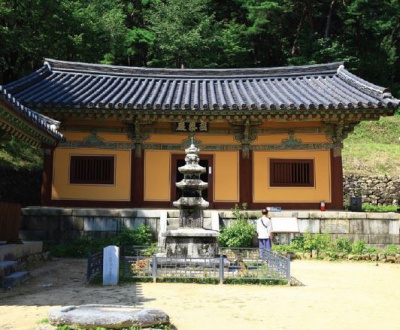Korea's Religious Places - 1.1.11 Bongjeongsa Temple (Andong, Gyeongsangbuk-do)
Bongjeongsa Temple (Andong, Gyeongsangbuk-do)
A temple not far from Buseoksa Temple, Bongjeongsa Temple was said to have been located there because the great Silla monk Uisang threw a stone from Buseoksa Temple that landed on the site, and that is where they built the temple, which means “a phoenix’s resting place.” According to tradition, it was built in 672, just after the Silla unification, and legend says it was founded by Uisang. However, a document found at the temple says it was founded by a disciple of Uisang named the Monk of Great Virtue, Neungin.
Bongjeongsa Temple has two National Treasures, and one of the two is especially noteworthy—the oldest building in Korea. The Geungnakjeon, the Hall of Extreme Bliss, a Goryeo-era building from the twelfth or thirteenth century, has that honor. By its title we know it is a hall of an image of Amitabha, again the central figure of Pure Land Buddhism, who also figures prominently in Uisang’s Hwaeom Order. Amitabha had great appeal in East Asia—China and Japan as well as Korea—during the eighth century. Uisang’s study in Tang China led him to study under masters who were captivated by the simple and popular appeal of the worship of Amitabha and rebirth in the Pure Land. Amitabha vowed that he would save anyone who only called his name, and this simplified version of Buddhism had great popular appeal in the spread of Buddhism, particularly in the seventh and eighth centuries and thereafter.
Bongjeongsa Temple is also famous for a recent event. In April of 1999, Queen Elizabeth II of England visited Korea and stopped at Bongjeongsa Temple as the only, and yet representative, site of Buddhism on her trip. She visited nearby Hahoe Village, a classic Confucian village, as well.
- Geungnakjeon Hall and Manseru Pavilion of Bongjeongsa Temple
In addition to National Treasure no. 15, the Geungnakjeon Hall, there is a newly recognized National Treasure, no. 311, the Daeungjeon Hall, located to its side. Whereas the older hall, the Geungnakjeon, is the hall of Amitabha, the Daeungjeon is the home of Shakyamuni, the historical Buddha who was once Siddhartha Gautama.
